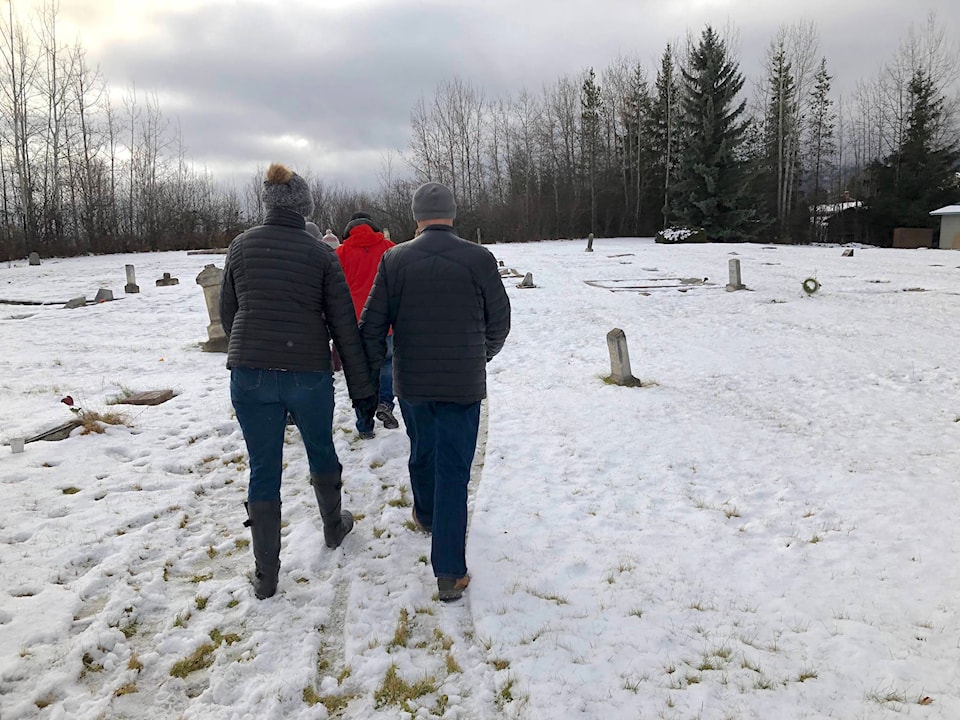Cemeteries can be a wealth of information and the one in Smithers is no different.
“Just as we know so much about ancient Egyptian culture from their funeral practices, and burials, our own cemeteries reflect our own beliefs about death and the afterlife and how those have changed over time,” said Bulkley Valley Museum curator Kira Westby. “They reflect social structures, cultural and religious costumes and even architectural and landscape trends.”
Westby led a group of 15 people on a walk through the Smithers Municipal Cemetery on Sunday. The annual event was done on two days this year. Saturday’s walk saw about 30 people come out.
Westby started the tour by explaining why the Smithers cemetery is located away from the original downtown core and why it has mostly simple grave markers.
She said these are the trends of the time when it was created in the early 1900s.
She said before the mid 19th century, burial grounds were located within city limits and usually connected to a specific church but by the 1850s, there was concern about the dead affecting the living through disease. There was also a shift in thinking that a busy city setting isn’t respectful for the dead. Also around that time there was a change in thinking about having cemeteries being attached to a church.
“This shift in thinking led to the development of park-like settings in rural areas, with trees planted, paths and beautiful benches,” Westby said. We are in the Victorian era now so they are creating these massive, beautifully-designed mausoleums and stones. They are showcasing their wealth and family standing.”
These ideas started to change around the turn of the 20th century. The customs change and a much simpler approach and an easier to maintain layout was invented. Westby pointed out the grass is much easier to cut on the newer side of the cemetery than on the older side with the bigger tombstones.
“All of those trends influence our cemetery, it came up in that era. The way it looks, why it is lacking the more ornate style and where it is located, this is all very textbook for an early 20th century cemetery.”
The town settled in 1913 but the earliest recorded burial is in 1917.
“We didn’t just have good luck that no one was dying for four years, people were dying but from what we can tell, people were being buried in Telkwa, or Aldermere, Hazleton or being transported back to a community where they can from.”
The Smithers Citizens Association [a group of businessmen that made things happen before there were elected officials] wrote to the province in 1916 to establish a cemetery but it took a year before it was created. In 1921 the Bulkley Valley Cemetery was formed and it was managed through this company with local funeral homes helping to maintain it until the town took it over in 1969.
Westby said the earliest internment on record in the Smithers cemetery is the grave of a woman named Eva Elizabet Naslund. Eva was born in Sweden in 1848. She married her husband Andrew sometime around 1880 when she was 32 and he was 20. According to a 1910 census they had 5 children.
“The family immigrated to the United States in 1903, travelling from Liverpool, landing at Quebec City and crossing at Vermont en route to their final destination of Everett, Washington,” said Westby. “They lived in Washington State until 1912 when they relocated to the Lake Kathlyn area. Why they chose to relocate to the Bulkley Valley remains unclear, but it is possible that they were attracted by the building of the railroad and the opportunities it presented. Andrew worked as a labourer and as a rancher, and they could have been lured by the promise of land.”
Naslund died of stomach cancer at the age of 69 on October 6 1917.
Westby ended the tour with several stories of past Smithers residents that help shape the town we now know.
Anyone interested in looking up people buried in the cemetery can check out findagrave.com.
The BV Genealogical Society has entered in all the tombstones into the website.
